From Samson to Rapunzel, from Cleopatra to Marie Antoinette, from beehives to Afros, hair and hairstyles have played an outsized role in human history and culture. Nails, too, have been objects of great care and obsession. We’ve been coloring and styling nails for at least 7,000 years.
You can see the extremes of our fixation on hair and nail health by perusing world records. The longest Mohawk spike, for example, was over four feet tall. The longest mustache reached over 14 feet. And the longest fingernails extended 24 feet (and took over two bottles of nail polish and 20 hours to manicure.
While you may not devote most of your waking hours to turning your hair and nails into world records or conversation pieces, if you’re like most people, you care about how they look. As we’ll see, there are sound evolutionary explanations for our enthusiasm for personal grooming. But how your hair and nails look isn’t just about being aesthetically pleasing to you or the people around you. The primary role of your hair and nails is actually to protect important areas of your body. And their health can say a lot about your overall well-being, including the state of your nutrition.
As such, it’s important to practice good hair and nail habits. Let’s look at how to care for your hair and nails, specifically through everyday diet and lifestyle habits that support their health.
The Science of Hair and Nails
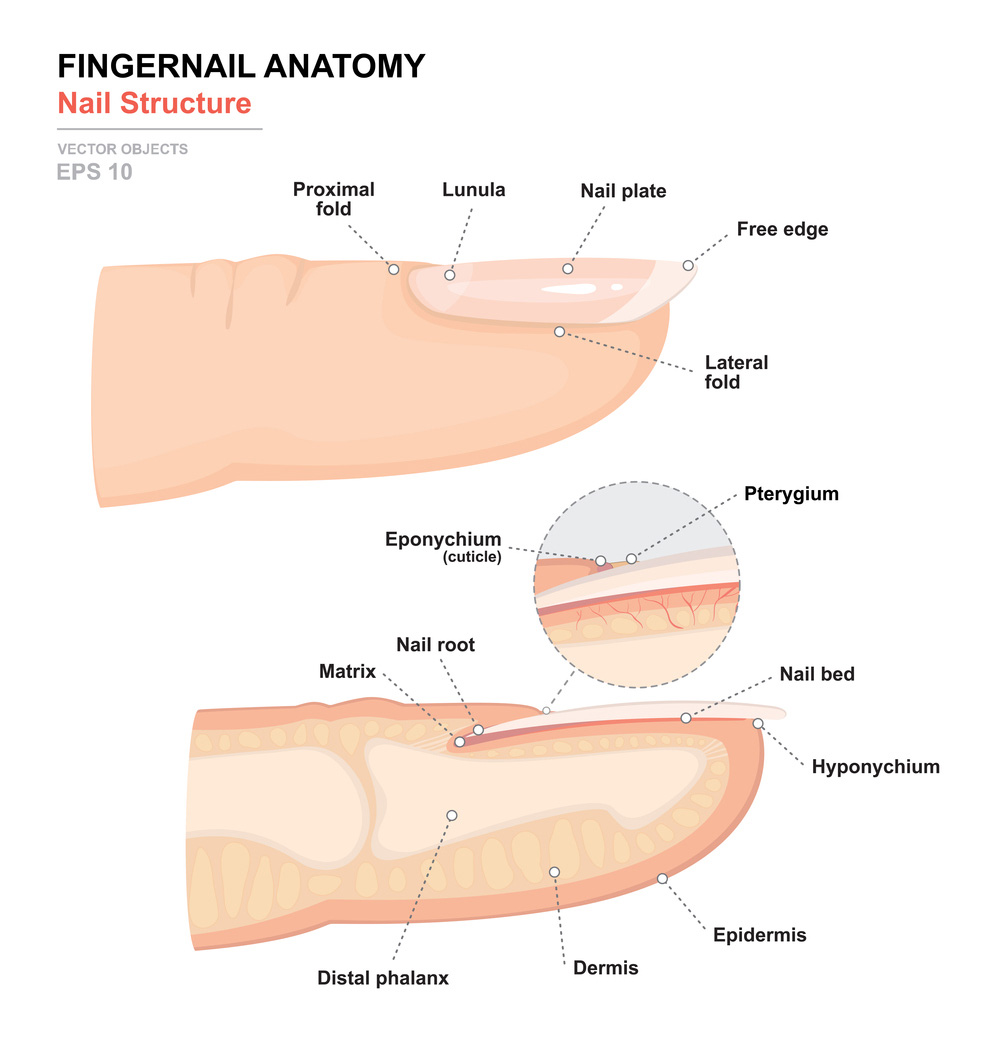
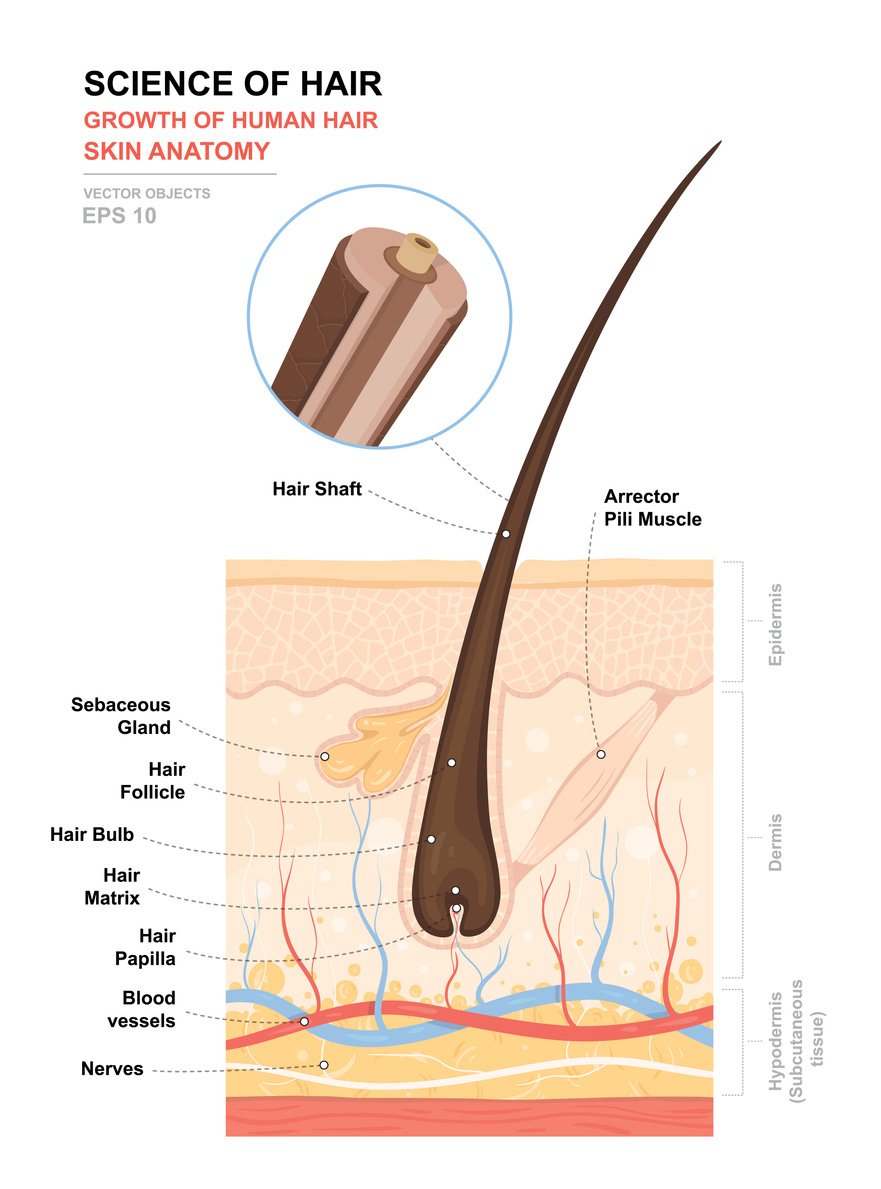
What are hair and nails? What are they made of that makes them so helpful for protecting us? And why do we even have them in the first place?
Hair
You may not want to think of yourself this way, but unless you have a rare condition called alopecia universalis, you are one hairy creature. Sure, you’re not furry like our close relatives, chimps and gorillas, but your body is almost completely covered in hair.
There are two types of hair: vellus and terminal. Vellus refers to the “peach fuzz” variety that’s pretty much everywhere except the palms of our hands and the soles of our feet. Terminal hair is the thicker, more visible, and longer hairs that form our head, eyelash, and eyebrow manes, as well as pubic hair and chest, back, and belly hair. How much of each type you have varies between people, and is also influenced by factors like sex and age. The average non-balding person has around 100,000 hairs on their head.
Hair is made up of a tough protein called keratin that’s less susceptible to being torn or scratched than other types of cells.
Hair is nourished by blood vessels that deliver nutrients to the cells in your hair bulb that sits underneath the hair follicle. From your hair bulb, cells divide and build the actual hair shaft. Blood vessels also transport hormones that modify hair growth and structure at different times throughout life.
Nails
Your nails are also made up of keratin, which stiffens and hardens epidermal (skin) tissue. Nails start growing underneath the skin; the part you can see is actually made of dead cells. As a new nail grows, it continuously pushes the old nail through your skin.
As for why the tips of your nails are white, this is because keratin is naturally translucent in color. The further they grow away from your nail bed, the less exposure they get to body oils and moisture, making them appear white. This is why your white tips turn clear when they are immersed in water for a length of time. (Go wash your hands if you want to check; I’ll wait.)
And that rainbow of pink near the base of the nail bed? That’s from tiny blood vessels called capillaries that circulate blood just below the nail.
Why We Have Hair & Nails
What’s the point of having hair and nails, anyway? Both serve a protective function for your body. Along with your skin, your hair and nails are a part of the integumentary system, or the set of organs that sit outside of your body (if you were a bird or horse, this would also include your feathers or hooves).
The integumentary system works together to help protect deeper tissues and internal organs, excrete waste, regulate your body temperature, detect pain, pressure, and sensations, and even maintain fluid balance. The state of your hair and nails can alert you to your body’s response to emotion or the environment. One example of this system in action is when your hair stands on end due to fear, danger, or cold.
The Purpose of Hair
Hair also insulates the body and protects against harmful UV rays. A lush mane of hair on the head can allow the head to stay cooler in the midday sun, and can keep heat from escaping from the body on chilly winter days and nights.
Why we dropped our fur, and kept long, thick hair only in a few places still baffles scientists. The thermoregulation argument holds sway with some; we’re strategically hairy and hairless in all the right places to keep our body temperature within a safe range. Some agree with Darwin that sexual selection did the trick: we preferred less hirsute mates because it’s harder for parasites to hide in wispy vellus hair. Also, some evolutionary psychologists point to the high time and energy costs of grooming a full head of hair, and suggest that such a display advertised wealth and status.
The Purpose of Nails
Nails also serve a variety of functional purposes. In addition to protection, they’re darn useful, as you know, if you’ve ever experienced a really good back scratch. They can help us grasp things. And, in a pinch, can allow us to play flamenco guitar without a pick.
While most mammals have claws, we primates dropped the big, sharp, scary things in favor of the much daintier fingernails and toenails, possibly to help us while we multitasked climbing and picking fruit.
And nails may also have served as a visual barometer of physical health, since changes that may take months or years to detect clinically can quickly change the color, texture, and shape of our nails. So we may have been attracted to mates with good-looking nails, as they are a reliable and visible signal to overall health.
Whether or not the attraction theory helps to explain the evolution of hair and nails in humans, we moderns have taken it to a whole new level. The global hair care industry’s market value was estimated at over $85 billion in 2017, while the nail care industry came in at just under $10 billion.
Medical Conditions That Can Affect Your Hair or Nails
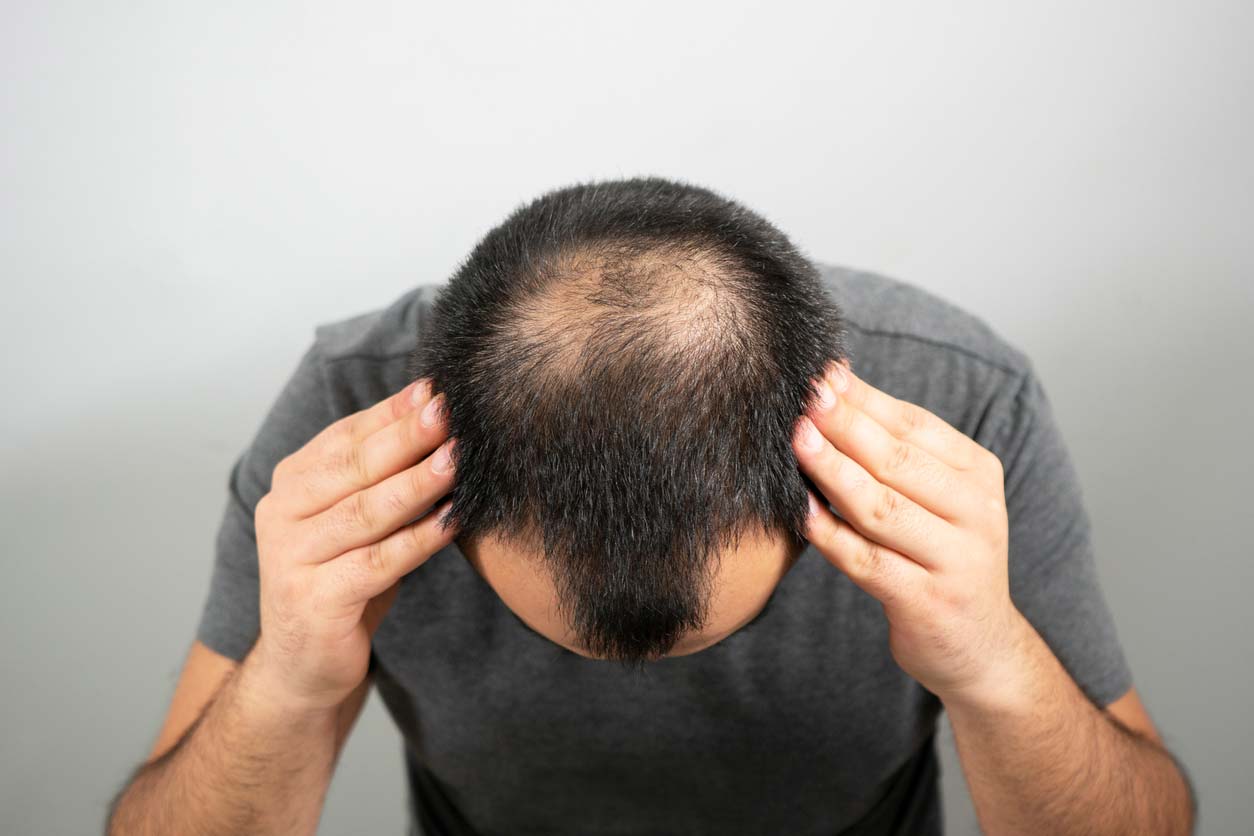
Given the wide variety of products and services we can use to make our hair and nails attractive, it’s easy to forget that the origin of this impulse was based on health. So if your hair or nails start changing in subtle or not-so-subtle ways that concern you, you might want to do more than just reach for the latest conditioner or head to the salon for a cosmetic fix. While these changes are often the result of something minor that goes away on its own, sometimes they might indicate an underlying medical condition that warrants further investigation.
Some of these potential conditions include:
Thyroid Conditions
Diseases of the thyroid can lead to thinning, coarse, or dry hair and eyebrows. You may develop soft, fine hair with bald patches, a noticeable change in how quickly or slowly your hair grows, and an itchy, dry scalp. Both hyper- and hypothyroidism can result in hair loss, but this is generally treatable once the condition is managed. Thyroid conditions may also cause your nails to become thick and brittle with rounded edges, soft and shiny, or begin to curve due to swollen fingertips.
Alopecia
Alopecia is a condition of hair loss that may be due to things like aging, hormonal changes, autoimmune disorders, or genetics. There are actually seven types of alopecia, each of which can result in varying degrees of hair loss and have different causes. The average adult loses between 70-100 hairs daily. But anything beyond that amount, or when hair doesn’t grow back, may indicate an underlying issue, such as alopecia. In general, alopecia is hair loss that may look like bald patches or a complete absence of hair in areas where it usually grows.
Lupus
Lupus is an autoimmune disorder in which your body attacks its own tissues and organs and results in systemic inflammation. With lupus, you can have hair loss, bald patches, and skin lesions, particularly on the scalp. It may also lead to redness and swelling around the cuticles, as well as pitting and ridging of the nails.
Circulation Disorders
One common circulation disorder is Raynaud’s, in which your blood supply to extremities, like fingers and toes, is inhibited or interrupted. During an attack, fingers or toes may turn white and then blue, followed by bright red as blood returns to them. Scleroderma is another common circulatory condition that targets arteries and tissues and can lead to nail changes like blue fingertips, abnormal growth called pitting or beaking, and the development of thick, brittle, yellow nails. Over 95% of people with scleroderma also have Raynaud’s.
Infections
Fungal infections of the nails can cause thick, brittle, yellow nails. This is commonly called “onychomycosis” and may be accompanied by a skin infection between the toes referred to as “athlete’s foot.” Scalp infections, caused by bacteria or fungi that enter hair follicles, usually cause redness, itching, and sometimes hair thinning.
If you’re experiencing any of the hair and nail symptoms discussed above, and don’t have a diagnosed medical condition that you already know explains it, it may be wise to speak with your healthcare provider for a comprehensive evaluation to see if you can determine the underlying cause.
Other Non-Nutritional Influences on Nail & Hair Health

Of course, there are numerous other factors that can influence your nail and hair health that may have nothing to do with a diagnosable medical condition.
Impacts on Hair Health
The importance of a healthy diet for healthy hair can hardly be overstated. I’ll discuss that in much more detail in a few minutes. But here are seven non-nutritional factors that may result in unwanted hair loss throughout various stages of life. Remember that not all of these will cause hair loss for everyone, and that these are not all-encompassing when it comes to possible hair loss triggers.
1. Fluctuations in hormones
Your hair may be sensitive to hormonal changes. In fact, the cycle of your hair growth, and your hair follicles, are influenced by the activities and levels of various hormones in your body. For instance, androgen hormones like testosterone act on sex-specific areas of the body.
You’ve probably noticed hormone-related hair changes throughout various phases of your life. During the awkward years of puberty, hair starts to grow thicker in some places than others. As you enter reproductive age, hair loss can occur, as can hirsutism, or male-pattern hair growth among women. Pregnant women often experience an increase in hair growth and volume, followed by hair thinning and loss following childbirth. And with menopause often comes hirsutism again, as well as hair loss in other areas.
For our article on how to balance hormones naturally, click here.
2. Cancer treatment
Chemotherapy is a well-known cause of hair loss. But the effects depend on the specific type of chemotherapy being used. Why does this happen? The goal of chemotherapy is to target rapidly growing cells in your body, and unfortunately, this also applies to some non-cancerous cells — like those that grow hair. For this reason, hair loss all over the body during cancer treatment is common. This may mean losing eyebrows and eyelashes, hair in the armpits and pubic area, as well as on the head.
For our article on simple steps you can take to help prevent cancer with diet and lifestyle, click here.
3. Use of certain medications
Some medications contribute to changes in hair growth, which can include hair loss. Some of the most common medications to have this potential side effect include cholesterol-lowering drugs, birth control pills, antidepressants, hormone replacement therapy, steroids, weight-loss drugs, thyroid medications when used inappropriately, and Parkinson’s drugs. The good news is that drug-induced hair loss is generally reversible if you’re able to stop using the medication causing it. And diet and lifestyle changes can reduce the need for many of the medications used to treat chronic illness.
4. Family history
Many adults, especially men, look to their parents to determine what their hair might look like as they age. Is baldness genetic? Maybe. When there’s a hereditary baldness factor in your family, it’s called pattern-baldness. And for men, this usually starts as a receding hairline in your twenties or thirties. An estimated 80% of men and 50% of women will experience pattern-baldness by the time they turn 80 years old.
5. Stressful events
Excess or poorly managed stress can cause many different health problems, including hair loss. Telogen effluvium is a type of hair loss related to extreme emotional stress. While the hundreds of thousands of hair follicles on your head are constantly rotating between growth phase (anagen) and resting phase (telogen), telogen effluvium causes your hairs to undergo a sudden shift into telogen all at once. While one bad day isn’t likely to cause this, prolonged extreme stress certainly can. Telogen effluvium tends to look like overall hair thinning, instead of bald patches. Fortunately, the hair loss is temporary and can normalize once the stress is managed.
For our article on four herbs that have been proven to help reduce stress, click here.
6. Excess sun
While we praise the sun for its ability to boost mood and vitamin D levels, too much sun can be harmful to your hair. In fact, UV exposure is the most frequent cause of structural and color damage to your hair. Interestingly, there are some hair care products (like Sun-Bum leave-in conditioner) that have built-in UV filters or act like a sunscreen to help prevent sun damage.
7. Hairstyling and treatment
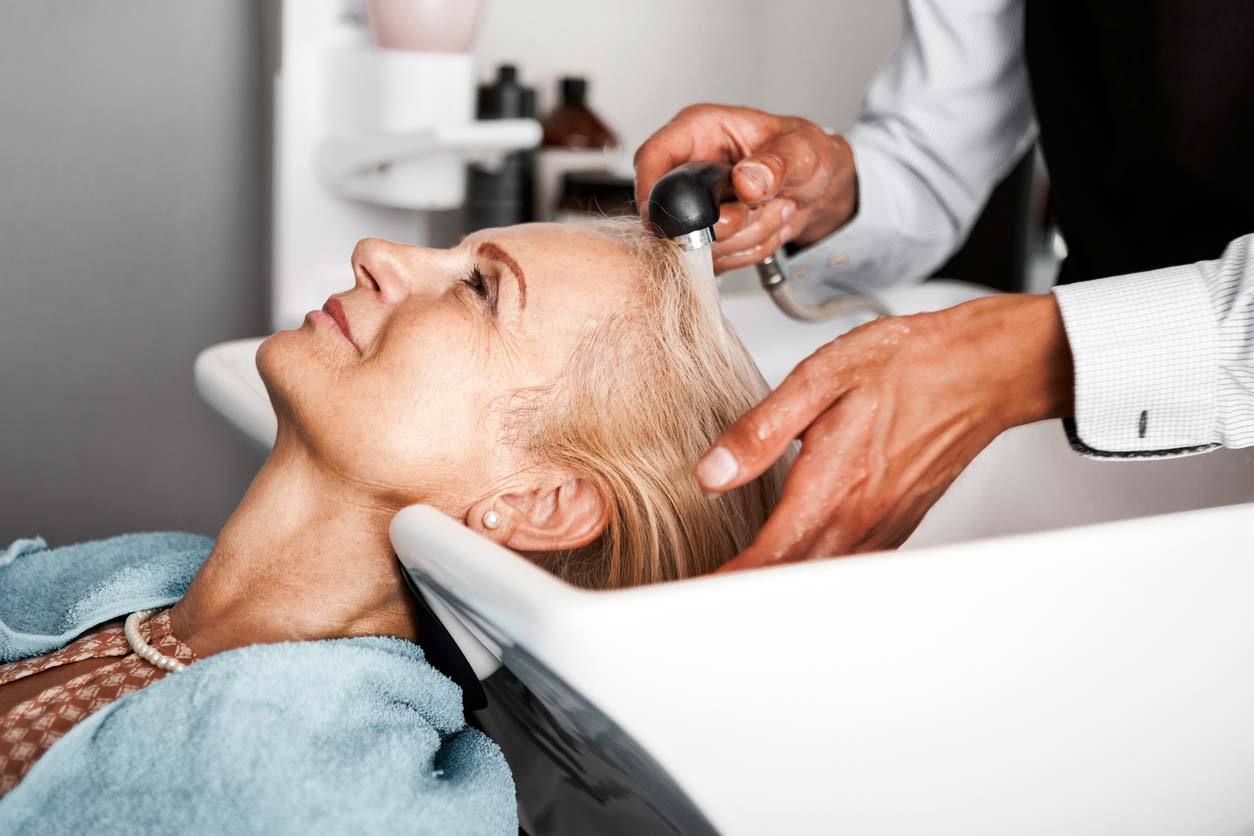
Hair upkeep can become an expensive habit, especially if you require a lot of trips to the salon to maintain a color or use high-heat tools and chemical products regularly. These things can also take a toll on the physical health of your hair. But everyday habits, like how you wash your hair, can also be a factor.
To minimize hair damage, experts say use conditioner after every single shampoo; resist the urge to rub shampoo into the lengths of your hair; don’t brush your hair when it’s wet; let your hair air dry as often as possible; and wear your hair loosely instead of firmly tied up. And if you frequent the salon, try to go at least 8-10 weeks between touch-up appointments for coloring and hair treatments.
But between hair treatments and hair products, there are a number of concerning chemicals you may want to look out for.
Hair Treatments
Chemical treatments, like perms and styling, are highly effective but can also be remarkably damaging over time. Many of these treatments use very high heat, which can cause breakage of your hair follicles. And many of the chemicals used in conventional hair treatments have potentially dangerous health consequences.
For instance, the Brazilian Keratin Treatment (also called a Brazilian blowout), which can make your hair straight for up to six months, uses formaldehyde releasers that can be toxic and carcinogenic.
And hair relaxers, which are used to permanently straighten hair without the use of hot irons, contain lye (or sodium hydroxide) that appears to put women of color at a higher risk for breast cancer. In a 25-year long study, researchers found that Black women who used lye salon products at least seven times per year for 15 years or more experienced a 30% increased risk for estrogen receptor-positive breast cancer compared with more infrequent users.
Dyes used to lighten hair, and perm chemicals, are also known to contain carcinogenic compounds called toluidines. Studies show that the amount of toluidines in your blood increases with more exposure to these types of salon products.
Hair Products
Most shampoos, conditioners, and other at-home hair products, unfortunately, aren’t innocent, either. Many of these contain chemicals that can cause contact dermatitis, and potentially other more severe reactions, including triggering allergies and causing damage to the immune system. Some examples include para-phenylenediamine, found in hair dyes, methylisothiazolinone, found in many shampoos, conditioners, hair treatments, and colors, cocamidopropyl betaine, found in many shampoos, conditioners, bleach treatments, and hair relaxers, and benzyl salicylate, found in certain hair styling aids, hair sprays, and hair serums.
Many widely used hair care products are also notorious for containing endocrine-disrupting chemicals, like parabens, phthalates, BPA, triclosan, and benzophenone-3. These have been widely studied for their ability to interrupt the body’s hormonal system and cause problems like thyroid disease, reproductive disorders, cancers, and pregnancy loss.
A 2016 study found that many endocrine disruptors are in hair care products specifically intended for women of color. These compounds may increase the risk for breast cancer, a disease which has a higher mortality rate among African Americans. A 2018 study found that hair products widely used among Black women and children contained multiple endocrine disruptors and chemicals that are associated with asthma.
Cleaner Hair Care Ingredients
For “cleaner” beauty products, look for ones that don’t contain the following:
- Sulfates
- Parabens
- Phthalates
- Mineral oil
- Retinyl palmitate
- Coal tar
- Hydroquinone
- Triclosan
- Triclocarban
- Formaldehyde and formaldehyde-releasing agents
- Synthetic fragrances
Impacts on Nail Health
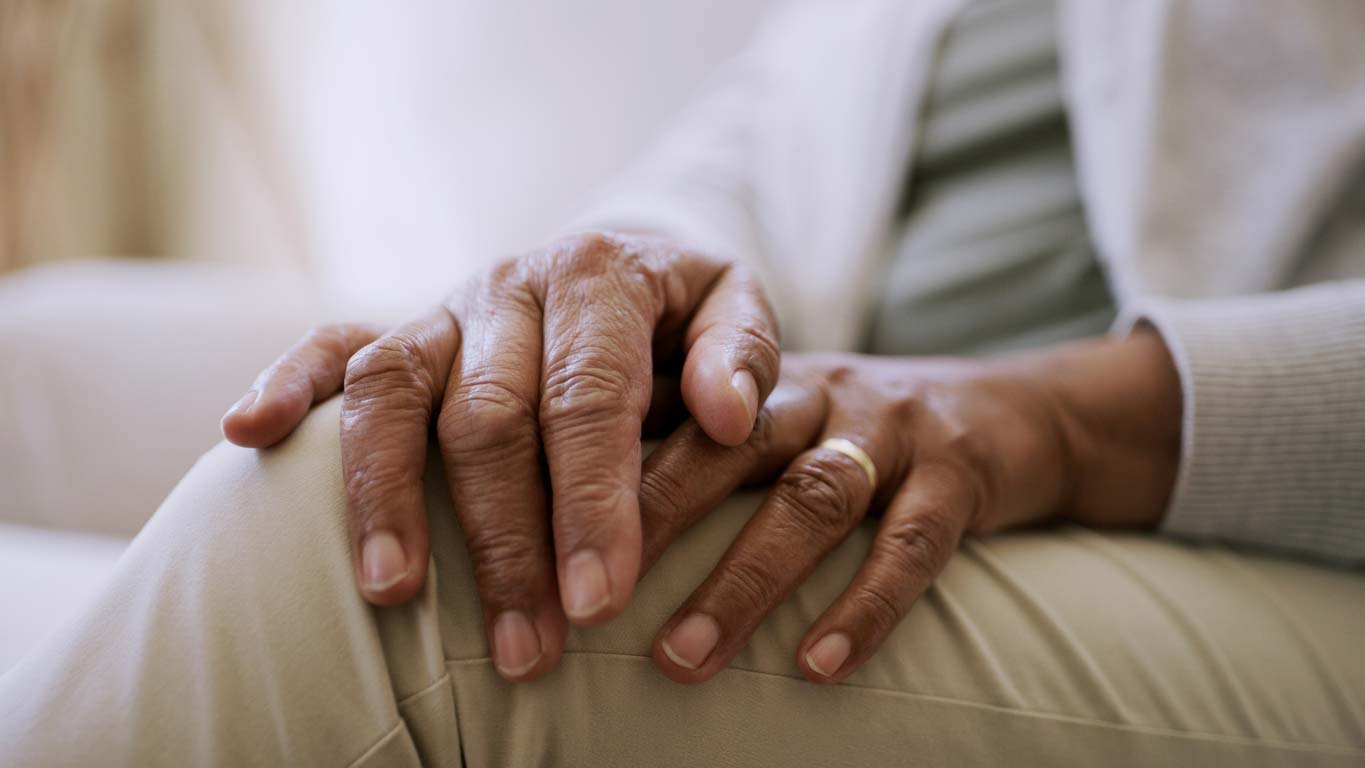
Your nails can also be highly sensitive to environmental factors and physiological changes throughout life. As with your hair, the importance of a healthy diet for healthy nails is so strong that it’s difficult to exaggerate. We’ll look at that in much more detail in a few minutes.
Here are three, non-nutritional causes of unhealthy nail changes. Of course, this list is not exhaustive, as there can be other reasons for nails to change over the years.
1. Getting older
It’s common to notice changes to your hair and nails as you get older. Many of these changes are harmless, and simply a normal sign of aging. Nail appearance can change with age, becoming more dull, brittle, and even translucent. And nail texture may also change, becoming harder or thicker — especially toenails.
However, it’s a good practice to monitor your nails for any significant changes, just like you would your hair, skin, moles, and freckles. As was mentioned earlier in this article, a number of health conditions can affect your nails, so if you notice any sudden or dramatic changes, you may want to bring it up with your healthcare provider.
2. Too much or too little moisture
The appearance of your nails can change depending on environmental factors. Onychoschizia is a common condition in which nails split, and is more often seen among women. Nails can become dry and brittle if they lack moisture, or become soft and brittle if they have too much moisture. The most common cause of these changes is repeated wetting and drying of the hands, like in the scenario of frequent hand-washing or using household cleaning products. Some people find that wearing rubber gloves when cleaning, using lotions that contain alpha-hydroxy acids, or taking biotin can help, though these positive reports are anecdotal.
3. Using nail polish or fake nails
Just as frequent visits to the hair salon can cause hair changes, excessive use of nail products can do the same to your nails. Nail polish is probably the most widely used nail treatment for all ages, and its chemistry has changed significantly over the years. For instance, many nail polish companies are making longer-lasting and no-chip formulas. But some sources suggest that while these are more durable, they come with risks that can impact nail health if you use them a lot.
Gel nail polish requires a removal system that can damage your nails. And wearing it for a long time can cause severe nail brittleness. Powdered polish also requires a harsh removal process, like an electric file, that may damage the nail bed and cuticle.
Additionally, some nail polishes contain formaldehyde, which (in addition to being a carcinogen) can cause brittle nails. Many nail polishes also contain phthalates, which are endocrine disruptors that are linked to issues such as diabetes, hormone changes, and thyroid irregularities. And nail polish removers usually contain harsh chemicals like acetone, toluene, ethyl acetate, and methanol, all of which have potentially concerning health effects.
6 Lifestyle Tips for Healthier Hair & Nails

As with overall health, there are several everyday habits you can practice to keep your nails and hair healthy — and consequently looking and feeling their best.
1. Practice good hygiene.
To help prevent nail infections and spread of germs, keep your nails cut short and filed, practice hand-washing that includes scrubbing underneath your nails, avoid biting your nails, and sterilize your nail tools before using (especially if you have them done in a salon setting).
Best practices for keeping your hair healthy include washing oily hair more often, concentrating your shampooing on your scalp and conditioner on the lengths of your hair, and protecting your hair from pool chemicals when swimming by wearing a swim cap or using deep conditioner afterward.
2. Don’t smoke.
Smoking isn’t just a bad idea for your lungs. Cigarettes can cause visible yellowing of your nails, as well as make them brittle. They can also make your hair dry and smell like cigarette smoke. And even if you normally have unnoticeable upper lip hair, smoking cigarettes can change that. A side effect of smoking called “smoker’s mustache” can cause tobacco-associated yellowing of upper lip hair.
3. Limit and manage your stress.
Left unmanaged, chronic stress can lead to hair loss. And while the average healthy person loses 50-100 hairs per day, stress often causes noticeable losses. Researchers have observed that, in animal studies, chronic stress can cause hair to go into an extended resting phase, without regeneration of the hair or hair follicle. This is thought to be due to elevated stress hormones in the body, making it difficult for new hair follicles to be formed and for resting hair to enter the growth phase.
Stress can also affect your nails, causing side-to-side lines to appear. If you can dial down the stress in your environment, that can be good for your hair (and your health!). But some stress is unavoidable. Practices like meditation, deep breathing, and good nutrition can help you navigate stressful situations with greater ease.
4. Limit the use of beauty products or treatments with harsh chemicals.
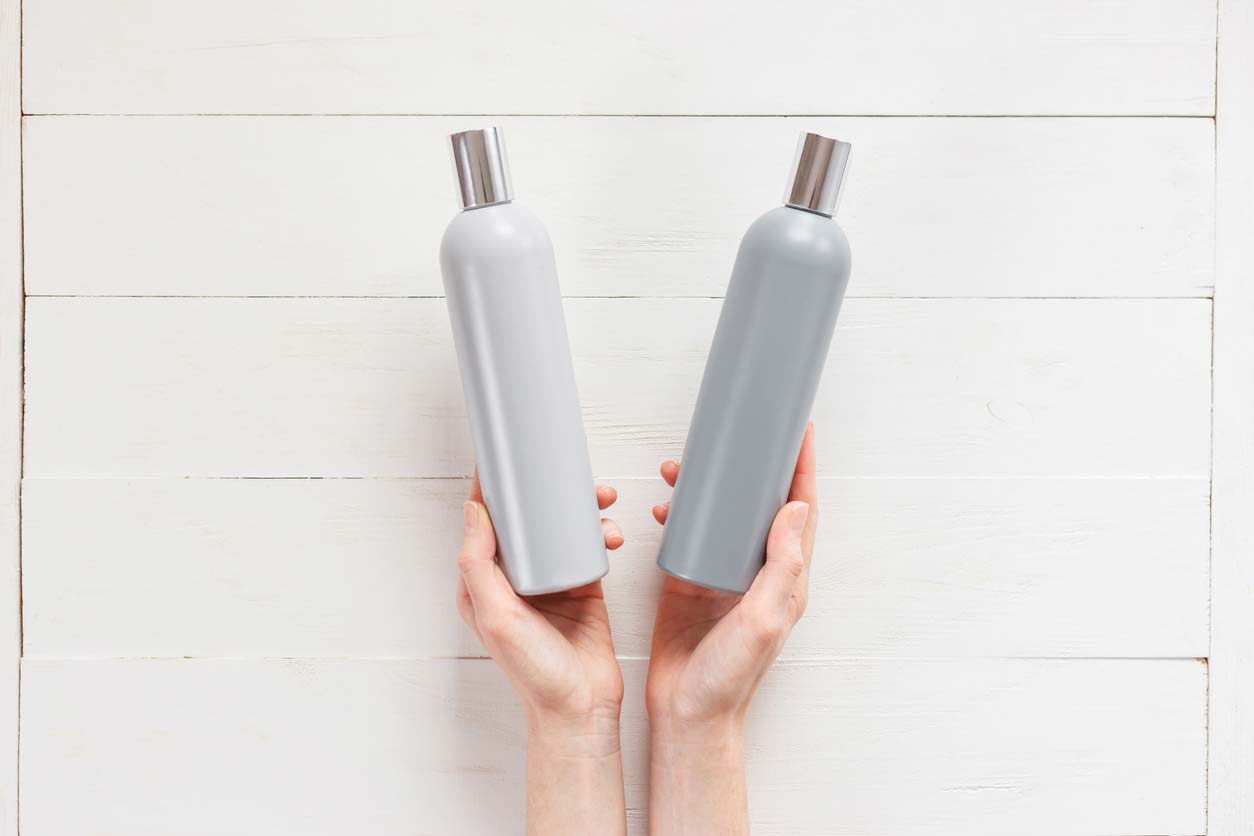
For hair and nail health — and frankly, overall health — look for personal care products that don’t contain dangerous amounts of harmful ingredients. Avoid chemical treatments, perms and permanent straighteners, lightening dyes, and ingredients like sulfates, parabens, triclosan, formaldehyde, and synthetic fragrances.
Things like chemical straightening, perms, years of coloring or bleaching, and even wearing extensions can lead to hair damage. Not to mention, many straightening chemicals contain formaldehyde or formaldehyde releasers, which are known carcinogens that can have skin and respiratory side effects.
Non-Toxic Polish
As for your nails, if you wear nail polish, consider choosing traditional nail polishes that are easier to remove with less harsh chemical applications, or even better, non-toxic nail polishes (particularly if you’re pregnant or nursing). Non-toxic nail polishes are identifiable by phrases like “3-free” or “10-free” on the bottle. These terms mean that the polishes are made without certain chemicals and additives. The higher the number, the more common toxic chemicals are left out of the ingredients.
Natural Oils
When it comes to hair products (and even some nail products), look for those that contain naturally-derived ingredients and oils. While hair products like shampoo or conditioner may not be as “sudsy” as the others, they still do the job, and you can feel good about what you’re putting on your hair.
Natural oils used in hair products include peppermint, which promotes hair growth without apparent risk for toxicity, as well as evening primrose, thyme, rosemary, lavender, cedarwood, olive, and tea tree oils, which may help promote healthy hair growth without harm, though more research is needed. Cuticle creams and other nail care products may also include beneficial oils and ingredients, including jojoba oil and vitamin E.
Aloe
Aloe, a gel derived from the aloe plant and often used to help alleviate sunburn pain, is another good natural hair care ingredient. A 2020 study that prepared non-toxic aloe-containing shampoos found them to have similar qualities and characteristics to their mainstream counterparts. Another study found that aloe-containing shampoo solutions actually had better foam stability, higher surface tension, and shorter wetting time than marketed shampoos.
Glycerin
Glycerin, a colorless, non-toxic natural humectant derived from natural plant seed oil, may also be worth seeking out. It draws moisture into your hair as a deep conditioner, can help eradicate scalp dryness, and strengthen damaged hair. Just read the labels to avoid glycerin derived from animal fats, as they’re not only unkind but also tend to dry your hair out further. Some products contain glycerin derived from the toxic and potentially carcinogenic chemical epichlorohydrin. To choose the best option, look for glycerin products that state they are USP Grade or non-GMO.
You can use the EWG Skin Deep Database to search for recommendations and seek out products that have been EWG Verified.
5. Limit time in the sun.
Your hair protects your scalp from the sun, but that doesn’t mean your hair doesn’t experience damage from too many rays. Protect your hair by wearing hats, scarves, or covering yourself with an umbrella if you’re planning to be in direct sunlight for a long time. Go outside in the early morning or later in the day when the sun isn’t as harsh. And consider using an SPF-containing hair product or zinc oxide cream on exposed areas of the scalp, as these are designed to protect your hair from sun damage.
6. Last but NOT least: Hydrate and eat a nutrient-rich diet.
What you eat and drink also has a major impact on the health of your hair and nails. Eating a diet based predominantly on whole plant foods fuels your body with vitamins, minerals, fiber, and antioxidants that work from the inside out to support your health (more on that in a moment). Staying hydrated internally can also help keep you hydrated externally, benefiting the health of your hair and nails.
Nutrients for Hair & Nail Health
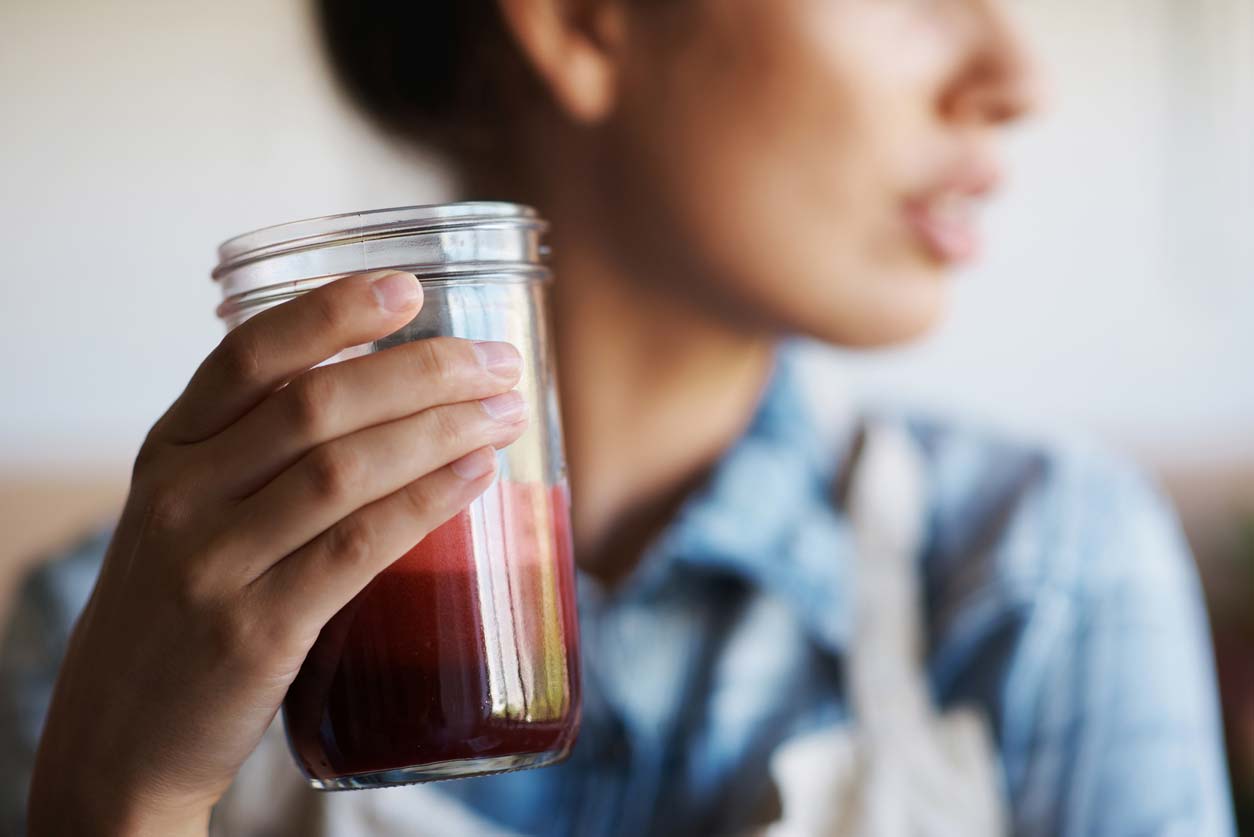
What you put in your body is just as (if not more!) important than what you put on your hair and nails. Changes to hair and nails can also result from nutritional deficiencies. Inadequate intake of specific vitamins and minerals, essential fatty acids, and even protein can cause inflammation, impaired wound healing, purple spots called petechiae that indicate broken blood vessels, excessive dryness, and changes in shape, color, and texture.
Some of the most important nutrients for nail and hair health are:
Iron
Your body stores iron in the form of ferritin. Having low ferritin levels can sometimes result in hair loss. Low ferritin levels can be caused by a dietary iron deficiency, hypothyroidism, pregnancy, menstruation, or having celiac disease. The healthiest way to boost ferritin levels is usually to increase your intake of iron-rich plant foods. For our article on iron, click here.
Zinc
Zinc is a cofactor in numerous processes in your body, including making strong proteins in your nails. Not getting enough zinc can result in brittle, cracked nails and slowed growth. It can also cause what is known as Beau’s lines, which are horizontal grooves that run across your nails. These are the most common presentation in nails that indicates a health change elsewhere in the body. For our article on zinc, click here.
Protein
While protein deficiency is very rare in western countries, as long as you’re getting enough overall calories, not getting enough can impact your nail health. After all, your nails are made of protein — specifically, one called keratin. Protein deficiency can be a risk in the elderly population, given the higher likelihood of poor appetite. Fortunately, getting enough protein is generally easy, even on a plant-based diet. For our article on plant-based protein, click here.
B vitamins
Nail brittleness, discoloration, blue nails, or brown streaks can be a sign of vitamin B12 deficiency. Some studies have found that B12 supplementation reversed these nail changes. However, other studies have also found that B12 supplementation doesn’t really help your nails unless you’re already deficient in this nutrient. As for your hair, not getting enough vitamin B12 may play a role in causing premature graying of the hair. For our article on B vitamins, click here.
Vitamin D
Vitamin D is metabolized in your skin by keratinocytes, skin cells that produce keratin, the protein that makes up nails and hair. If you don’t have enough vitamin D, keratinocytes can’t regulate the growth of your hair. Research has found that vitamin D deficiency is associated with excess hair shedding, autoimmune alopecia, and female pattern hair loss, and that deficiency can worsen hair loss over time. Vitamin D deficiency may also show up on your fingers as peeling nails. For our article on vitamin D, click here.
Vitamin C
Vitamin C acts as an antioxidant and assists with the synthesis of collagen, the primary protein matrix that makes up hair, nails, and skin. Not getting enough vitamin C can lead to dry, brittle nails and slowed nail growth. Plus, eating vitamin C improves the absorption of iron, another important nutrient for hair and nails. The good news is that vitamin C can be found in a wide variety of plant foods. For our article on vitamin C, click here.
Omega-3 fatty acids
In a 2015 study, people who took omega-3 and omega-6 supplements reported thicker hair than those in a control group. And a 2018 study found that fish oil rich in omega-3s stimulated hair growth in rodents. Omega-3 fats can be found in fatty fish, and also in plant-based sources like flax seeds, chia seeds, walnuts, and algae-derived DHA and EPA supplements. For our article on omega-3 fatty acids, click here.
Excess Nutrients
On the other hand, there are a few nutrients that in excess can also cause unwanted issues with your hair and nails. Getting too much selenium can lead to nail brittleness and hair loss. And too much vitamin A can also lead to hair loss as well as cracked nails.
Best Plant Foods for Hair and Nails
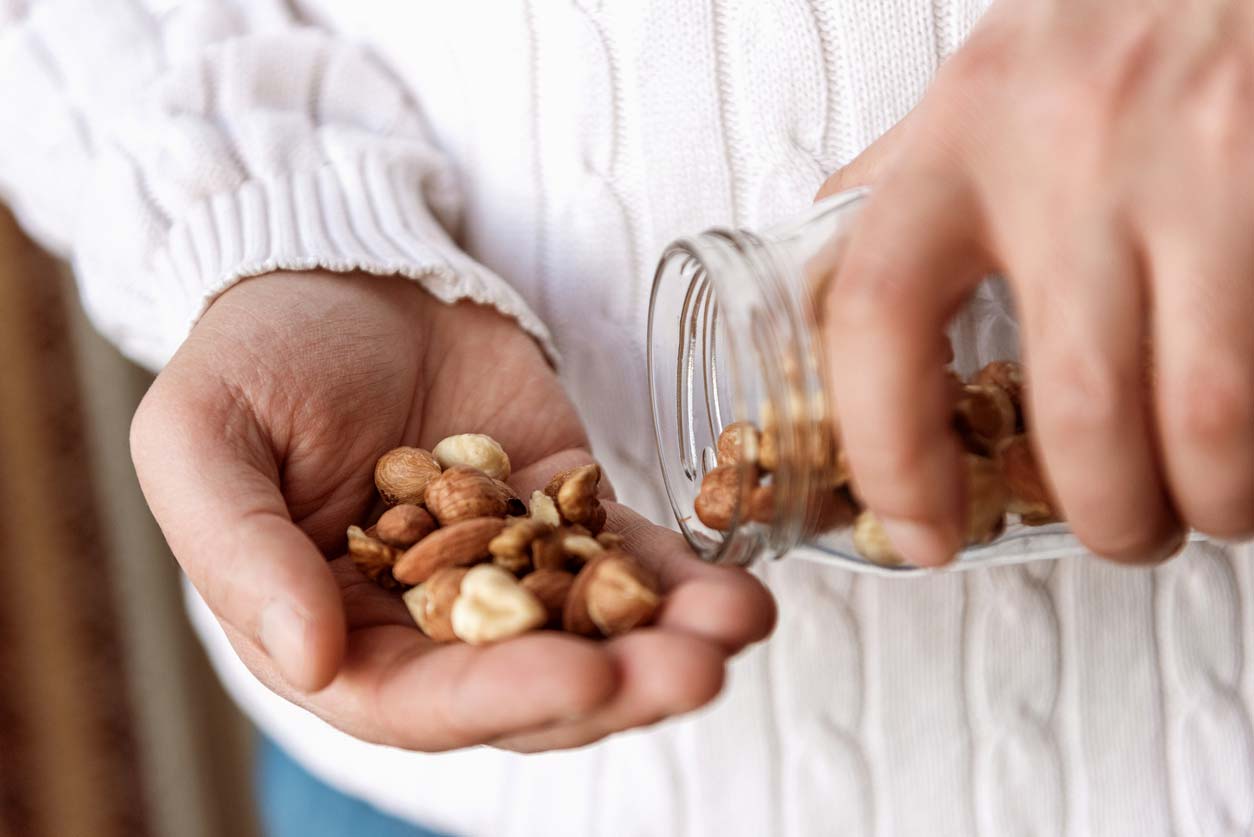
Where are the best places to find the nutrients your hair and nails need? Overall, eating a widely varied diet based primarily on whole plant foods is a great approach. But these foods, in particular, are some of the best plant-based sources of nutrients known to promote hair and nail health:
- Nuts and seeds for healthy fats, selenium, zinc, iron, and protein
- Avocados for monounsaturated fats, B vitamins, and vitamin C
- Legumes for protein, iron, and B vitamins
- Oats for iron, zinc, protein, and B vitamins
- Berries for vitamin C and antioxidants
- Tofu and tempeh for protein, zinc, and iron
- Mushrooms for selenium, zinc, B vitamins, and vitamin D if they were grown using UV-light
- Sweet potatoes for vitamin C and the B vitamins
- Citrus fruits for vitamin C
- Mangos for vitamin C
- Leafy greens for vitamin C, iron, and zinc
Getting the Nutrients You Need
All of these tasty foods are super versatile and easy to include in your diet in the ways you enjoy most. For example, I love adding leafy greens and berries to smoothies, making avocado toast, mixing mangos into oatmeal, sauteing mushrooms and tofu, using cooked lentils in homemade veggie burgers, and snacking on nuts and seeds. You’ll find some other favorite ways to use these foods in the recipes below.
Eggs and fish are also high in protein, omega-3 fats, vitamin D, and iron. And oysters are a particularly rich source of vitamin B12 and zinc. However, they also come with some ethical and environmental concerns. And as you can see, there are plenty of plant-based foods that are good sources of the nutrients you need for good hair and nail health.
For a few specific nutrients, namely vitamin D, vitamin B12, and omega-3 fats, it’s widely recommended to supplement if you follow a totally plant-based diet. For more on the top nutrients that vegans and vegetarians should consider supplementing, click here.
Recipes for Better Hair and Nail Health
You might notice that the recipes below have one thing in common — they’re chock-full of colorful, healing plants that — surprise! — nurture healthy hair and nails. Whether smoothie bowls are your jam (Tropical Delight Smoothie Bowl), salads are your go-to (Thai Millet and Peanut Salad does not disappoint), or your kitchen screams for savory bowls (find the super-est superfood bowl in the Blackened Tempeh and Sweet Potato Bowl with Avocado and Kale), we’ve got you covered!
1. Tropical Delight Smoothie Bowl

You can probably feel the nutrient density of this bowl just by looking at it. Pineapple, kiwi, and mango contain vitamin C and carotenoids. Bananas are a good source of prebiotic fiber. Chia seeds are chock-full of omega-3s, and pistachios are a good source of protein. Your hair and nails are thanking you already.
2. Thai Millet and Peanut Salad
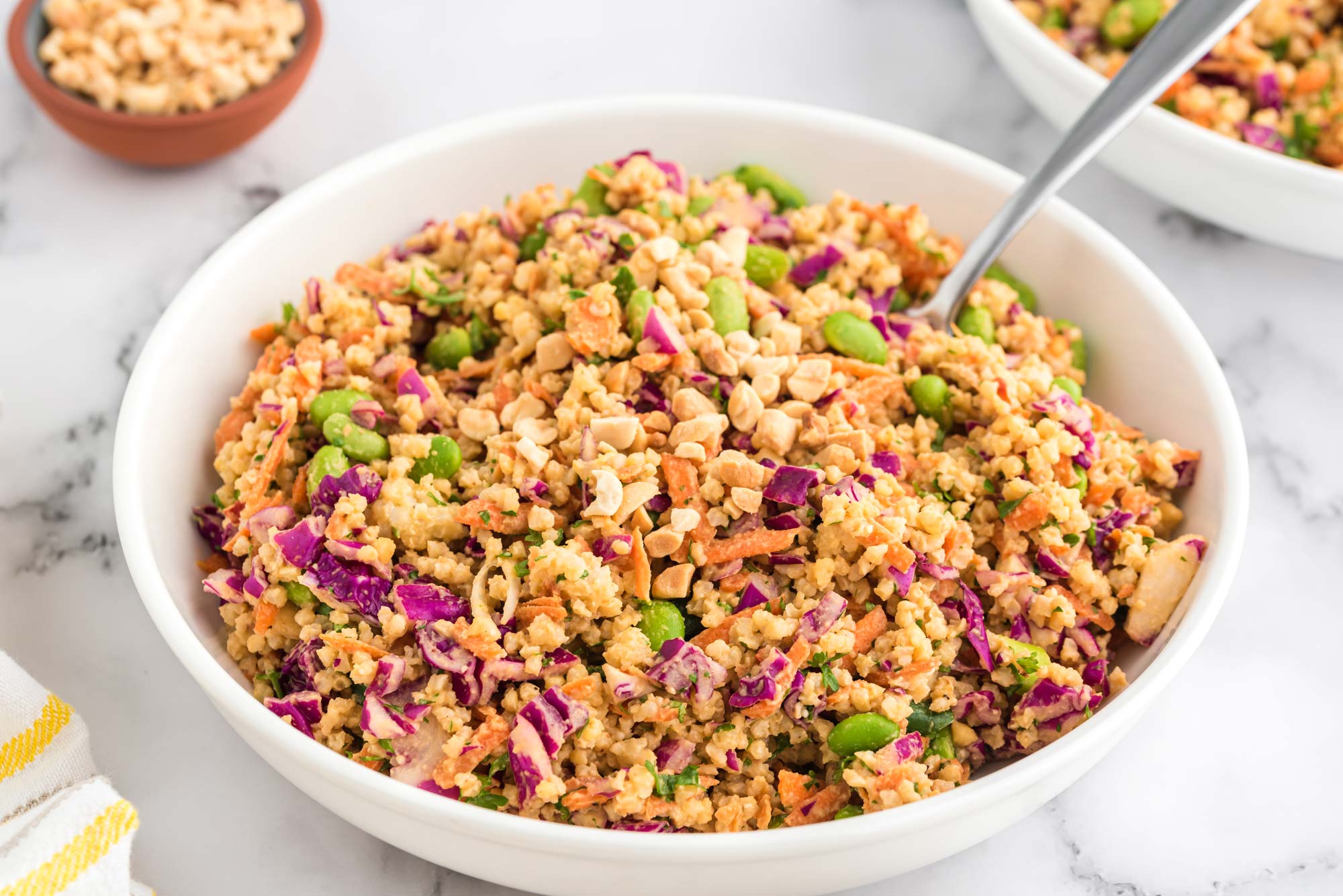
Peanuts and edamame, two members of the legume family, are sources of biotin, an essential nutrient for healthy hair and nails. Millet, like many whole grains, contains B vitamins like folate, thiamin, niacin, and pyridoxine (B6). Plus, this salad contains a variety of colorful, plant-based foods and fits into a well-balanced, nutrient-rich diet to support healthy hair and nails.
3. Blackened Tempeh and Sweet Potato Bowl with Avocado and Kale

Tempeh is a superfood for many reasons — gut health, heart health, and now, skin and nail health! It’s rich in biotin, B vitamins, and protein. Sweet potato also has biotin as well as carotenoids and B vitamins, while avocado brings the healthy fats. And kale is loaded with B vitamins and carotenoids, too. Perhaps we should have named this the Superfood Hair and Nail Bowl (though that name doesn’t sound quite as appetizing, for some reason)!
Help Your Hair and Nails Help You
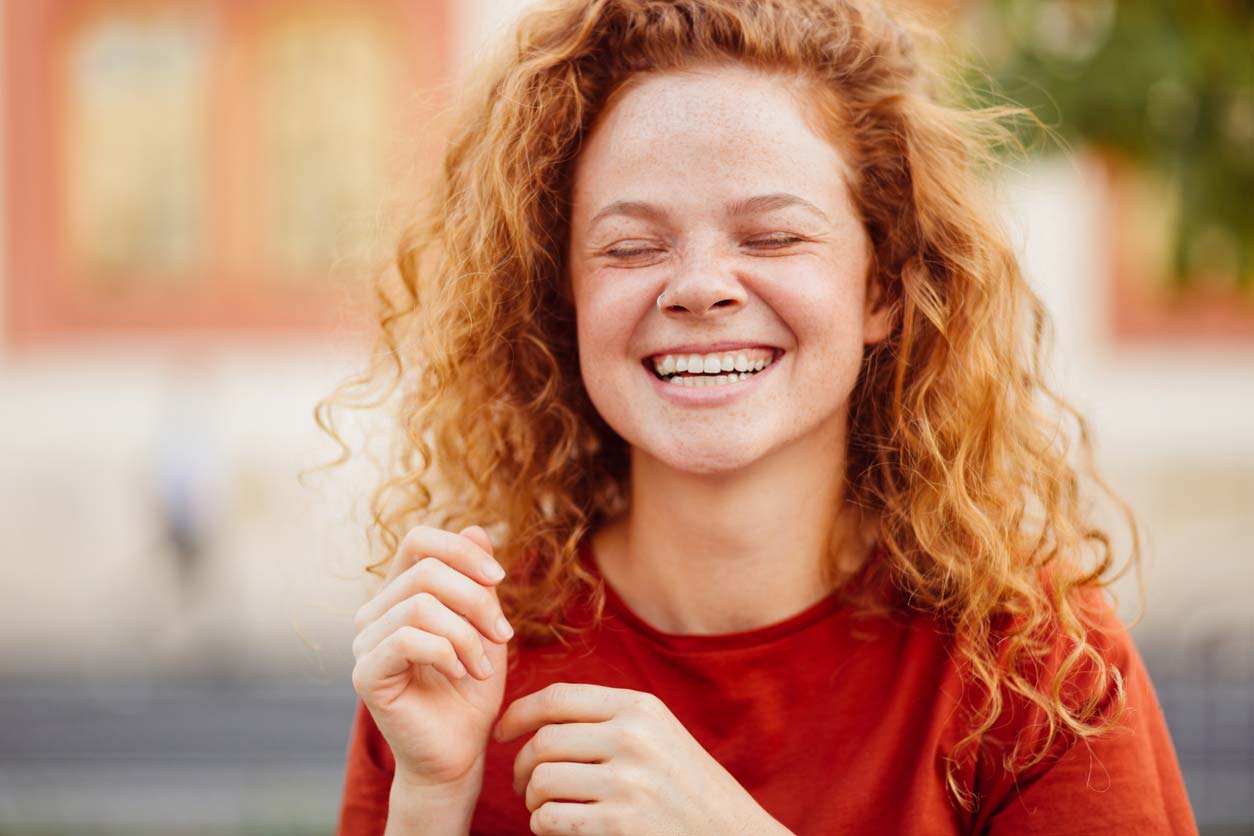
Your hair and nails are an important part of your overall health, as well as offering protection from the elements. Take care of them by choosing personal care products that have been crafted for safety, avoiding excess sun exposure, and practicing good hygiene habits. Eating a well-balanced, nutrient-rich diet and leading a healthy lifestyle are also important ways to support the health of your hair and nails. When you give your body what it needs on the inside, it’s often reflected on the outside.
Tell us in the comments:
- Have you ever experienced a change in your hair or nails that was related to diet or lifestyle?
- Have certain diet and lifestyle changes improved the appearance of your hair or nails?
- What are some ways you can get more of the nutrients for hair and nail health listed above?
Feature image: iStock.com/Cristalov




